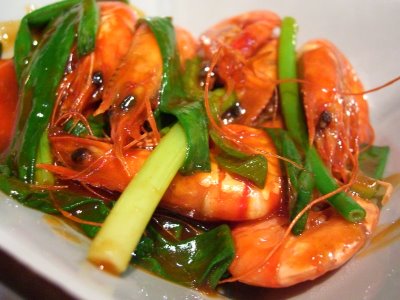History in a bowl of prawns

One of the great things about food blogging is that you get exposed to, and are encourage to explore, different exotic ingredients and cuisines. From rosewater to truffles, harissa to mentaiko, every meal becomes a culinary flight of fantasy into faraway worlds, every day a new discovery.
And so you scour markets and catalogues, track down reknowned chefs at their latest endeavours, and plan holidays or spare moments during business trips around the procurement of the best local produce or the latest hot restaurant.
Amidst all these pursuits, it's easy to forget that the best food is often what you grew up with. Which is funny in Singapore, where a simple walk around the neighbourhood can saturate your culinary senses:
The piercing smell of spices, sharp and pungent.
The shrill cries of hawkers inviting you to sit and partake.
Fiery woks in a state of perpetual motion.
Roasted meats hanging off skewers, waiting to be carved.
Rice of all colours, drenched in vivid gravies.
Thick, viscous coffee streaming out of well-worn pitchers.
Jewel-like cubes of dessert peeking out of beds of shaved ice.
All this amidst the neverending chatter of coffee shop talk in what seems to be a million different dialects.
Cooking at home is no less varied. Cantonese, Hokkien, Teochew, Malay, South Indian, Peranakan (itself a fusion of Chinese and Malay cuisines), Malaysian (a mix of all the above plus some unique dishes), Singaporean (all that plus), Western (bastardized to varied extents)... all fall into my category of food I grew up with, my native cuisine.
I'm therefore making a conscious effort to cook (and therefore blog about) more Singaporean food in all its guises, colours and flavours.
First up, one of my favourite growing up dishes that's planted pretty firmly in the category of 'Cantonese' - Chow Har (literally Fried Prawns).
I found the recipe for this dish in the great bible of Singaporean home cooking - Mrs. Lee's Cookbook. Mrs. Lee's Cookbook is one of the cornerstones of Singapore's short history as a nation, and can be found on almost every kitchen shelf here - it's as if a copy is handed out together with your citizenship. As if that wasn't sufficient contribution to shaping Singapore's collective social consciousness, Mrs. Lee is also the mother of Lee Kuan Yew, Singapore's first Prime Minister and undoubtedly the most influential person in Singapore's history.
The first edition of the book was published in 1974 and till this day, thirty years later, is still the best selling cookbook in the Malay Archipelago. In 2003, Shermay Lee, Mrs. Lee's granddaughter and founder of Shermay's Cooking School, relaunched the cookbook in an updated, full-colour edition. The New Mrs. Lee's Cookbook subsequently won at the Gourmand World Cookbook Awards 2003 in the category of Special Awards of the Jury (English – Rest of the World), testifying to the relevance of its recipes to a whole new generation of Singaporeans and beyond.
I'm proud to be the owner of a 1983 edition of the original book, which was passed to me by my dad shortly after I moved to Beijing. Compared to the elaborate and lush cookbooks of today, the original Mrs. Lee's Cookbook seems sparse, even unforgiving. Black line drawings of ingredients and dishes fail to visually inspire, and refuse to offer any additional guidance as to whether your dish will turn out as it should. Dishes and spices in their native Malay names intimidate any newcomers or non-natives - Assam Pedas? Ayam Buah Keluak? Heepeow? Do those sound even vaguely edible?
What the book does offer that few others can though, is the comfort and pride that you're cooking using recipes that have been handed down through the generations, the appreciation of food as an integral part of Singapore's social fabric.
It's easy, when cooking, to pretend that you're a little god, controlling the fates of ingredients, amalgamating and alchemizing to suit your whims. But a flip of Mrs. Lee's Cookbook humbles you - you realize that these are dishes that have been around for generations, that countless hands have put together over the years and will continue to do so for many more years to come. Dishes that trigger a million childhood memories and that today you can't live without. As funny as it may sound, you realize that food is bigger than you. Indeed, Mrs. Lee's Cookbook isn't just a collection of cherished recipes - its pages also contain a brief exposition of Peranakan history and women's lives in a Straits Chinese household; illustrations of traditional Nonya wedding dress; translations of frequently used ingredients' names between English, Malay, Chinese, Indonesian, Thai, Tamil and Tagalog; a foreword by Mr. Wee Kim Wee, former president of Singapore; and an example of Chinese calligraphy - strong reminders of the bonds between food, history, society and culture.
And so, on to the prawns! This is a very simple, toss-everything-together-and-fry recipe that shouldn't take more than 5 minutes to prepare, all in. The sauce is strong, thick and sweet - remember when eating a traditional Chinese meal, all meat and vegetable dishes are placed in the center of the table and shared. Your own little eating space is contained in an individual bowl of rice, on which everything is placed. Serve the prawns the same way and you'll find that, once all the prawns have been shelled and devoured, your rice is now covered with a layer of the sauce, which makes for a second round of enjoyment that is in no way inferior to the first.
Chow Har
Serves 4 as part of a 3- or 4-course dinner
1kg (2lbs) large prawns, seasoned with salt
(Mrs. Lee suggests that you "remove a band of shell from the centre of the prawn, trim the feelers & sharp tips." She also suggests that the finished dish is served on a platter garnished with cucumber and tomato slices, which was probably a lot more attractive in the 1970s than today. Feel free to experiment with both the presentation and 'user friendliness' of the prawns - in familiar company both steps can be easily skipped to no overwhelming detriment.)
12 stalks spring onion, cut into short pieces
8 tbsp oil
For the gravy, boil together:
1 tsp salt
1 1/2 tbsp sugar
1/2 tbsp cornflour
6 tbsp ketchup (the original recipe quaintly calls for 'tomato catsup')
1 tbs oyster sauce
1 tbsp ginger juice
1 tbsp wine
2 tbsp water
Hopefully I'm not violating a copyright by reproducing the below instructions verbatim from the book. I just loved their staccato pacing - short, succinct and punctuated. You can really imagine your own grandma standing behind you in the kitchen guiding you with the exact same words:
"TO COOK: Heat a frying pan until very hot, add in 8 Tbs. oil. When the oil is
hot, add in the prawns. Stir fry until cooked. The hot oil seals in the juices
of the prawns. Pour the sauce over the prawns, and stir in the spring onions.
Serve immediately."




2 Comments:
I so agree with you. I have been trying to learn how to cook Asian food more in the last few years whereas when I was younger I was all about gourmet French, rustic Italians et al. I love Mrs Lee's book too. It was my lifeline when I was Europe, teaching me how to cook Asian food.
By Stephanie, At
12:16 PM
Stephanie, At
12:16 PM
Hi MM!
Yah it's funny how Western cuisine is usually the first port of call, when there are so many fabulous and exotic ingredients in local cooking that are really worth exploring!
By hinata, At
11:32 AM
hinata, At
11:32 AM
Post a Comment
Subscribe to Post Comments [Atom]